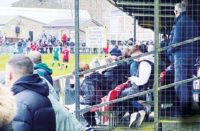As part of The Football Association's move towards a pure Pyramid for the National League System, the Non-League landscape is in the middle of its biggest transition period in years.
This season has seen the introduction of a fourth division at Step 3 and a seventh at Step 4.
From 2020-21, there will be an eighth division at Step 4 to address the travelling distances from the north east to the Peterborough area and today football's governing body are revealing the changes at Steps 5, 6 and 7.
The NLP were invited to Wembley to discuss all things restructuring as we sat down with Head of National League System Laurence Jones, National League System Manager Matt Edkins, Leagues Committee chairman Ray Lewis and vice-chairman Mark Frost.
NLP: The restructuring of the National League System is clearly a major piece of work. Where are you in the process?
Laurence Jones: From 2020-21, there will be the introduction of an eighth division at Step 4. We're in the middle of the selection process to appoint a league to run that. It's been tendered as the new divisions at Step 3 and 4 for this season were.
We are looking to introduce two new divisions at Step 5 to take it up from 14 to 16. That process is underway now too. We are redefining Step 6. There are currently 19 (20 from 2019-20) leagues at Step 6 and that will be reduced to 17, of which two will be based in the south-west.
Then at Step 7, we are looking to improve consistency and create stronger relationships between County FAs at that level of the game.
NLP: How will you make the numbers fit in time for 2020-21?
Mark Frost: It's the same number of clubs just reshuffled. You're going to have a balance of Step 6 clubs because we're reducing from 20 leagues to 17. It's important we tell the clubs now so they know how the end of next season will pan out before they kick a ball.
Matt Edkins: It's all done on promotion at the end of next season. It's not a case of hand-picking teams we want to go up. It's all based on on-field performance.
Subject to FA Council approving the regulations, there will be 24 clubs promoted from Step 5 to 4. The introduction of the eighth Step 4 division will look to address some of the travelling challenges in the north of the country.
The 14 champions across Step 5 will go up, with second and third place in the North West Counties, Northern League and Northern Counties East also automatically promoted. The remaining 11 second-place clubs will then be ranked on Points Per Game and the four highest will also be promoted to make the 24.
Then with the remaining seven second-placed clubs – again a one-season scenario – will play-off with the seven bottom-placed clubs at Step 4 for a winner-takes-all game. So the Step 4 club wins and remains at the level or the Step 5 club wins and swaps places. It's the principle that you are still at risk of being relegated and it's not a dead rubber season.
There will be 76 clubs from Step 6 promoted to Step 5 – two clubs from each of the two South West Peninsula divisions and the top four from all other Step 6 divisions.
NLP: How will ground grading work for the clubs going into the new Step 4 division from Step 5?
ME: Historically we had the E Grade to get promoted from 5 to 4 and we removed that because we needed to have automatic promotion.
We've reintroduced Grade E from next season but we're not going to make it a promotional grade. So we can still have automatic promotion between 5 and 4 but, by March 31 of the 2019-20 season, any club promoted from Step 5 this summer will have to get the E Grade. Then, 12 months after that, they have to get the D Grade. It's moving it slightly so it doesn't become a promotion blocker from 5 to 4 and it's a gradual increase, as opposed to making the jump from the F to the D in a 12-month period, which has been quite challenging for some.
NLP: How will promotions work going forward from Step 3 to Step 2? Obviously this season only six clubs will go up, with two through a super play-off.
LJ: There won't be a super play-off next season.
ME: Step 2 will be increasing from 22 clubs to 24 for 2020-21. So next season the bottom two in the National League North and South will be relegated. That allows for all of the champions and play-off winners at Step 3 to be promoted so we don't have the super play-off. Then from 2020-21, four clubs will be relegated from each Step 2 division.
NLP: What will the promotion/relegation process between Step 4 and Step 3 be next season?
ME: At Step 3 the bottom two clubs in each division will go down along with two third from bottom on PPG. Then going up will be seven champions and seven play-off winners.
Once the structure is in place it will be a clear path. If you start at Step 6 and aspire to go to Step 1, you will have a greater understanding from a geographical point of view of the likely league you will go into. We hope it will all make clubs more robust and ensure year-on-year we get less drop-outs.
NLP: Last season we saw the late withdrawal of Shaw Lane and the significant knock-on consequences for other clubs who had to be reshuffled into different leagues. How have the regulations been tweaked in reaction to that?
Ray Lewis: This year we've put a deadline on clubs who withdraw for whatever reason. We don't want to be in a situation as we had last year. We moved clubs very late on last season, which we had to do because of the regulations, but it was far from ideal.
MF: Now once we've released the allocations for the next they're set. If a club withdraws, the league runs one short.
ME: A league can adjust their own tables (prior to its AGM). If the vacancy was at Step 3, they could reprieve the next in line and run one short at Step 4, for example.
LJ: We have a responsibility to provide guidance to clubs. Through the County FAs and the leagues, that's an area of the game where there is more opportunity to support the clubs.
NLP: Can you explain why the new divisions at Step 5 will be focused on the Midlands and west London/Thames Valley area?
MF: The mapping exercise for Steps 5 and 6 is for the benefit of the clubs. We've done all the work on where the clubs are and taken out the scenario of the existing leagues. We've put the groups together and now we're going back to the leagues to say, ‘Which one of these groups would you like to run?' Our remit is to make sure the clubs play football in the best manner.
NLP: How will promotion from 5 to 6 in the south-west work?
RL: We've spent a lot of time in the south west to address this. We've agreed that Cornwall FA will run a Step 7 league and Devon FA, because it's a larger county, will run two Step 7 leagues. That's happening from next season.
MF: Then at Step 6, Devon and Cornwall will promote only the champion and not the top two like the other leagues.
NLP: How will Step 7 operate in the future?
LJ: Step 7 will become a feeder into the National League System. The leagues have readily supported it, as have the County FAs, at the two meetings we've held in the last two weeks.
RL: They still run as an individual league, we're not saying they're going to be taken out of the structure completely, they are going to be repositioned as a feeder league to the NLS and are going to be more aligned to a County FA and be the pinnacle of county football.
LJ: Rather than be the bottom end of the National League System, they're going to be the top end of county football. That will allow County FAs to develop their own localised pyramids that feed into that. It also allows us to ensure there's a clear and consistent process for clubs coming into the National League System at Step 6.
There are a variety of ways clubs end up at Step 6. There will always be an exception and there is provision for that. But I think the expectation on the FA is the norm will be that clubs come through that Step 7 feeder process into the National League System.
RL: They're not losing any benefits that they've had before. There's the opportunity of grants, playing in the FA Vase – all the benefits they had in the past of being Step 7 and part of the National League System, they will still get. There's no loss as far as that's concerned.
The main reason for doing this is the standard of Step 7 leagues throughout the country – the facilities they have, the standard of football – is so, so different and the majority of clubs would find great difficulties in getting their grounds up to the grading required.
LJ: We did a mapping exercise across a number of leagues as to the quality of facilities and the results were quite alarming. There's a very significant number of clubs a long way off meeting the grading for Step 6.
Actually when you talk to the clubs, a lot of them are happy in their own skin. They're happy playing at a good level of county football. They don't necessarily have the facilities, the resource, the finance to progress through the National League System – that's not their aspiration. They want to have a good offer of football in their own locality.
As the governing body you've got to understand what the stakeholders want and shouldn't force clubs at that level of the game to do things they're not in a place to do. That relationship between the County FA, the leagues and the clubs at Step 7 is absolutely crucial.
ME: There's an acknowledgement the game becomes more formal at Step 6. You come into Standardised Rules rather than Standard Code of Rules, which was causing a bit of conflict where some competitions operate with Steps 5, 6 and 7 – running with two different sets of rules doesn't make it easy for volunteers to navigate. So we felt the separation made sense provided nobody loses out on the benefits Ray's mentioned.
LJ: The change doesn't stop a club progressing into the National League System. What it does is reduce the pressure on those clubs who don't want to. That door is open via application. We're not doing any clubs at this level of the game any favours if we force them through a system.
However, when a club comes into the National League System, you do it in the full knowledge you're playing highly regulated football that will include promotion and relegation and, in some cases, lateral movement.
MF: If you run a grassroots park pitch side and you've got aspirations to go to Step 6, you've got a huge task to go from park football to that level. So we thought, ‘Let's introduce a step where they can get a leg up and only have so much more to go'.
The problem was defining the minimum ground grading requirements for Step 7. We came up with what we thought was a reasonable set of grading requirements, sent it out to the leagues and the response we got back was only two of the 45 leagues in the country met that. So we've had to water it down.
Currently you've got a myriad of standards. We asked: What should be the core standard? Some leagues will say they want fixed posts and rails, some will say they want floodlights. But others will say they just want the ability to play football and put up a temporary rail around the pitch.
This is all for the benefit of the clubs and we've found a lot have said, ‘Step 7 is the pinnacle we aspire to. We're very happy'.
LJ: A number of these clubs are really valuable community clubs. It's not just about the first team on a Saturday. It's the tail that comes with these clubs. So that relationship between the club, the league and the County FA, if it's focused on community, becomes even more critical.
ME: An important point to make is Step 7 isn't impacted by the restructure – the two new divisions at Step 5, the new division at Step 4 and the reorganisation of Step 6 – because it's just a movement of clubs within that Step 1-6 bracket. We'll still take promotions from Step 7 to compliment what we've got but it was key to make sure they were impacted.
NLP: Do you see this reshuffle as a bigger test than last year?
LJ: Definitely. You've almost got to put the two together. It was always going to be a phased approach and credit to the FA Leagues and Alliance Committees – they've worked together and taken a strategic approach to the restructure with clubs at the heart of it. I think the end result is a really exiting National League System and it's created a vibrant, robust system that allows clubs to progress and improves the sustainability of the overall pyramid.























